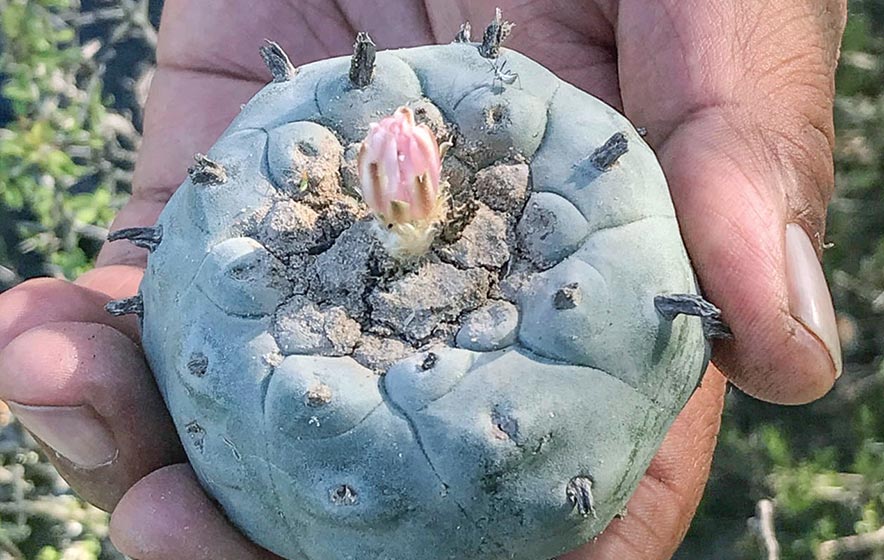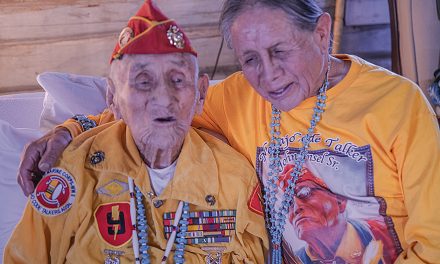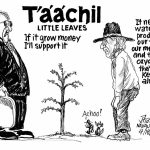
‘Our way of healing’: Azee’ Bee Nahagha working to protect peyote from state decriminalization

Courtesy photo | Hershel Clark A blooming peyote button sourced from Texas.
WINDOW ROCK
In last week’s Law and Order Committee meeting, Azee’ Bee Nahagha of Diné Nation leadership presented a resolution and pleaded that the Navajo Nation Council oppose the potential decriminalization of peyote (Azee’) by certain states in order to protect and preserve the Peyote Way of Life.
ABNDN (formerly Native American Church of Navajoland) resolution recognizes that peyote is sacred among the Navajo people and has been consumed for religious, cultural, and ceremonial purposes since time immemorial.
“Our primary interest is to protect the peyote in terms of the decriminalization movement nationally,” said ABNDN President Willie Tracey. “Protecting the medicine is of utmost importance to us.”
Hinaah Azee’ Summit
As a follow-up, on Monday, May 23 (9 a.m. to 4 p.m.), ABNDN will be hosting a Hinááh Azee’ (“living medicine”) summit at Twin Arrows Casino Resort, which is open to the public, to inform stakeholders and discuss what further actions to take.
“Azee’ Bee Nahagha of Diné Nation will be sponsoring a summit, enhancing awareness about the decriminalization of peyote movement at the state level and how that is threatening the American Indian use of peyote for bona fide religious ceremonial purpose,” said ABNDN Vice President Albert Johnson.
Thorough examination of the impact will be presented from a legal standpoint by Justin Jones, attorney from Jones Law Office, said Johnson.
Other presenters will include Delegate Eugenia Charles-Newton, chairperson of the Law & Order Committee, President Jonathan Nez, Native American Church leaders/members as well as traditional Hataalis. The agenda will be distributed at the event.
As of right now, there are no states where possession of peyote, except for members of Native American tribes, is legal.
“Our primary concern is protecting the peyote, because Public Law 103-344 highlights that only federally recognized tribes are able to utilize peyote in a bona-fide ceremony,” said ABNDN President Willie Tracey. “It only gives us the right to use peyote to pray with.”
However, with the recent widespread legalization of cannabis and research being done on the beneficial health effects of some psychedelic drugs, such as psilocybin (mushrooms), the concern is that the peyote, which contains mescaline, could one day become legalized across the board.
“The worst-case scenario is that the states and societies around Indian Country may one day legalize the use of peyote for medicinal or even recreational use,” said Delegate Thomas Walker.
ABNDN further cautions widespread personal and corporate cultivation of peyote cactus could threaten the historical, cultural and biological integrity of the plant by potentially exposing the population to hybridization, genetic modification and sterilization.
Walker, who has served the ABNDN organization in various leadership roles since1985, said that the purpose of the summit is to share information, invite feedback and develop next steps.
“This is an opportunity for our people that believe in Azee’ Bee Nahagha to come together to understand our need to protect our way of worship, our way of healing,” said Walker.
“It’s critically important that we understand the issues in the country,” he said, “and how we can address them together.”
Religious freedom
The U.S. American Indian Religious Freedom Act of 1978 protects the rights of Native Americans to exercise their traditional religions by ensuring access to sacred sites, use and possession of sacred objects, and the freedom to worship through ceremonials and traditional rites.
In 1994, Congress passed an amendment to further strengthen the law and provide for protected use of peyote as a sacrament in traditional Native American religious ceremonies.
As amended, ARFA states that the “use, possession, or transportation of peyote by an Indian for bona fide traditional ceremonial purposes in connection with the practice of a traditional Indian religion is lawful and shall not be prohibited by the United States or any state.”
The federal law further states that the traditional ceremonial use of the peyote cactus as a religious sacrament has for centuries been integral to a way of life and is significant in perpetuating tribes and cultures.
However, while at least 28 states have enacted laws that are similar to, or in conformance with, the federal AIRFA regulation, 22 states have not done so.
In its resolution, ABNDN says the movement to decriminalize peyote use could also directly threaten availability and the integrity of ceremonial use for Navajo and other Indigenous peoples. It also would be contrary to the doctrine of federal pre-emption, whereby federal law supersedes state law.
“I certainly hope states will comply with the law and our medicine will be protected, because we are thinking for our children so that in another 50 or 100 years they can practice and enjoy our way of life when we are no longer here,” said Tracey.
‘This is inter-tribal’
Tracey said that he’s hoping that all organizations at the summit can learn from one another about what the implications of the decriminalization of peyote would be.
He added that while there are other substances and plants that contain mescaline, they are not ABNDN’s concern.
Walker says the effort to raise awareness about decriminalization will require NAC groups across Navajo and the U.S. to work together to inform the public about the sacred use of peyote as medicine and sacrament before it’s too late.
“This is inter-tribal, a nationwide tribal concern,” he said. “It isn’t just Navajo. But by Navajo stepping up, I think that alerts everyone else in the country and that’s a good thing that we can do.”
Walker said the ABNDN also states in its mission that peyote is meant to be kept in its natural state.
“Meaning, leave it alone, don’t disturb it, don’t change it, don’t be making peyote greenhouses,” said Walker.
According to Tracey, the other big issue is that while the number of NAC practitioners is growing, there is already a limited and diminishing supply of peyote, which ABNDN sources from locations in Texas during an annual pilgrimage.
“There’s very limited areas where peyote still grows,” he said.
Some of the land that used to be used to grow peyote is being bought and converted to use for other purposes, he said.
The ABNDN resolution recognizes that the number of peyote plants has decreased in recent years, threatening the long-term sustainability of aboriginal habitats, and depleting the number of peyote plants that could be available for future generations.
Hershel Clark, spokesperson for ABNDN, said many tribes and Native American Church organizations, including ABNDN, want to preserve the peyote in its natural aboriginal habitat in southern Texas.
“There are also tribal efforts to urge the federal government to set land aside for conservation projects to preserve the peyote in Texas,” said Clark. “So, the decriminalization of peyote effort also includes the protection and preservation of land where peyote is grown naturally.”
In response to ABNDN’s resolution, delegates Walker and Charles-Newton are simultaneously working on drafting a supporting Council resolution that will oppose the decriminalization of peyote except for use for religious purposes by federally recognized tribes.
Use of peyote on Navajo Nation is legal as a sacrament within Native American Church services.
Information: hclark@bhcaih.org or www.abndn.org








 Highway 264,
Highway 264, I-40, WB @ Winslow
I-40, WB @ Winslow